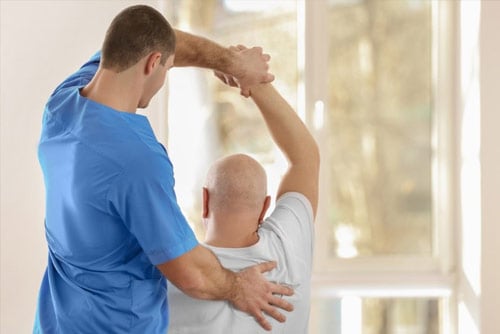Physical Therapy Options for Lower Back Pain
By Dr. Stephen Cosentino
PRESIDENT OF EMPIRE MEDICAL TRAINING
- Spinal Osteoarthritis
- Facet Joint disorders
- Sacroiliac (SI) joint disorders
- Disc Bulge (derangement and/or herniation)
- Muscle or ligament strain
- Spondylolisthesis or Spondylosis
- Chronic /Episodic back pain including muscle strain; positioning, or daily activities.
- Early intervention of 2 to 7 days post trauma injuries
- Non-neurological disorders or negative exam
- Referred Pain (muscular) symptoms
 Interventional uses for physical therapies include both manipulation and mobilization for the identified pain and may include alignment, osteopathic, and motion techniques. Massage is also sometimes prescribed for myofacial release, cross friction, and trigger point release. Electrical stimulation is also prescribed including TENS, IFC, NMES, Iontophoresis, and the use of ultrasound. The benefits of ultrasound may include increasing micro vascular to affected areas, phonophoresis to reduce inflammation, and to distract pain of arthritis or to supplement exercise. Traction is also still prescribed for pain disorders or degenerative disc disorders and can be manual, positional or mechanical. Other modalities may include decompression, exercise, cardiovascular, or muscle strengthening techniques. Gait training is often a form of strengthening where patients learn to do daily activities in a safe manner and re-train muscles that have become atrophic. This CME PRA Category 1 Accredited Pain Management Course incorporates many injury prevention concepts such as lifting, para-spinal muscle exercises, and body mechanics.
These are some of the options available and utilized today for lower back pain, as part of your Interventional Pain Management Education we will go over all of your options available to prescribe physical therapy for your patient including education and weight management for patients. There is a new standard of care expected with performing pain management procedures that is expected from conventional therapies to post-treatment options. Understanding the benefits and need for physical therapy will allow for better outcomes.
Interventional uses for physical therapies include both manipulation and mobilization for the identified pain and may include alignment, osteopathic, and motion techniques. Massage is also sometimes prescribed for myofacial release, cross friction, and trigger point release. Electrical stimulation is also prescribed including TENS, IFC, NMES, Iontophoresis, and the use of ultrasound. The benefits of ultrasound may include increasing micro vascular to affected areas, phonophoresis to reduce inflammation, and to distract pain of arthritis or to supplement exercise. Traction is also still prescribed for pain disorders or degenerative disc disorders and can be manual, positional or mechanical. Other modalities may include decompression, exercise, cardiovascular, or muscle strengthening techniques. Gait training is often a form of strengthening where patients learn to do daily activities in a safe manner and re-train muscles that have become atrophic. This CME PRA Category 1 Accredited Pain Management Course incorporates many injury prevention concepts such as lifting, para-spinal muscle exercises, and body mechanics.
These are some of the options available and utilized today for lower back pain, as part of your Interventional Pain Management Education we will go over all of your options available to prescribe physical therapy for your patient including education and weight management for patients. There is a new standard of care expected with performing pain management procedures that is expected from conventional therapies to post-treatment options. Understanding the benefits and need for physical therapy will allow for better outcomes. 

